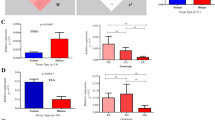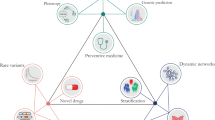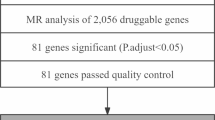Abstract
Psoriasis (OMIM 177900) is a chronic inflammatory skin disorder of unknown pathogenesis affecting ∼2% of the Western population1. It occurs more frequently in individuals with human immunodeficiency virus2, and 20–30% of individuals with psoriasis have psoriatic arthritis3. Psoriasis is associated with HLA class I alleles4,5,6, and previous linkage analysis by our group identified a second psoriasis locus at 17q24–q25 (PSORS2; ref. 7). Linkage to this locus was confirmed with independent family sets8,9. Additional loci have also been proposed to be associated with psoriasis10. Here we describe two peaks of strong association with psoriasis on chromosome 17q25 separated by 6 Mb. Associated single-nucleotide polymorphisms (SNPs) in the proximal peak lie in or near SLC9A3R1 (also called EBP50 and NHERF1) and NAT9, a new member of the N-acetyltransferase family. SLC9A3R1 is a PDZ domain–containing phosphoprotein that associates with members of the ezrin-radixin-moesin family and is implicated in diverse aspects of epithelial membrane biology and immune synapse formation in T cells11,12. The distal peak of association is in RAPTOR (p150 target of rapamycin (TOR)-scaffold protein containing WD-repeats)13,14. Expression of SLC9A3R1 is highest in the uppermost stratum Malpighi of psoriatic and normal skin and in inactive versus active T cells. A disease-associated SNP lying between SLC9A3R1 and NAT9 leads to loss of RUNX1 binding. This is the second example of loss of a RUNX1 binding site associated with susceptibility to an autoimmune disease15. It also suggests defective regulation of SLC9A3R1 or NAT9 by RUNX1 as a susceptibility factor for psoriasis.
This is a preview of subscription content, access via your institution
Access options
Subscribe to this journal
Receive 12 print issues and online access
$209.00 per year
only $17.42 per issue
Buy this article
- Purchase on SpringerLink
- Instant access to full article PDF
Prices may be subject to local taxes which are calculated during checkout



Similar content being viewed by others
References
Menter, A. & Barker, J. Psoriasis in practice. Lancet 338, 231–234 (1991).
Duvic, M. Immunology of AIDS related to psoriasis. J. Invest. Dermatol. 95, 38S–40S (1990).
National Psoriasis Foundation Bulletin. Psoriatic arthritis more common than suspected. 33, 6 (2002).
Tiilikainen, A., Lassus, A., Karvonen, J., Vartiainen, P. & Julin, M. Psoriasis and HLA-Cw6. Brit. J. Dermatol. 102, 179–184 (1980).
Nair, R.P. et al. Localization of psoriasis-susceptibility locus PSORS1 to a 60-kb interval telomeric to HLA-C. Am. J. Hum. Genet. 66, 1833–1844 (2000).
Capon, F., Munro, M., Barker, J. & Trembath, R. Searching for the major histocompatibility complex psoriasis susceptibility gene. J. Invest. Dermatol. 118, 745–751 (2002).
Tomfohrde, J. et al. Gene for familial psoriasis susceptibility mapped to the distal end of human chromosome 17q. Science 264, 1141–1145 (1994).
Nair, R.P. et al. Evidence for two psoriasis susceptibility loci (HLA and 17q) and two novel candidate regions (16q and 20p) by genome-wide scan. Hum. Molec. Genet. 6, 1349–1356 (1997).
Enlund, F. et al. Analysis of three suggested psoriasis susceptibility loci in a large Swedish set of families: confirmation of linkage to chromosome 6p (HLA region), and to 17q, but not to 4q. Hum. Hered. 49, 2–8 (1999).
Bowcock, A.M. & Barker, J. Genetics of psoriasis: the potential impact on new therapies. J. Am. Acad. Dermatol. 49, S51–S56 (2003).
Reczek, D., Berryman, M. & Bretscher, A. Identification of EBP50: a PDZ-containing phosphoprotein that associates with members of the ezrin-radixin-moesin family. J. Cell Biol. 139, 169–179 (1997).
Itoh, K. et al. Cutting edge: negative regulation of immune synapse formation by anchoring lipid raft to cytoskeleton through Cbp-EBP50-ERM assembly. J. Immunol. 168, 541–544 (2002).
Kim, D.H. et al. mTOR interacts with raptor to form a nutrient-sensitive complex that signals to the cell growth machinery. Cell 110, 163–175 (2002).
Hara, K. et al. Raptor, a binding partner of target of rapamycin (TOR), mediates TOR action. Cell 110, 177–189 (2002).
Prokunina, L. et al. A regulatory polymorphism in PDCD1 is associated with susceptibility to systemic lupus erythematosus in humans. Nat. Genet. 32, 666–669 (2002).
Speckman, R.A. et al. Novel immunoglobulin superfamily gene cluster mapping to a region of human chromosome 17q25 harboring a locus for psoriasis susceptibility. Hum. Genet. 112, 31–41 (2002).
Bickeboller, H. & Clerget-Darpoux, F. Statistical properties of the allelic and genotypic transmission/disequilibrium test for multiallelic markers. Genet. Epidemiol. 12, 865–870 (1995).
Martin, E.R., Monks, S.A., Warren, L.L. & Kaplan, N.L. A test for linkage and association in general pedigrees: the pedigree disequilibrium test. Am. J. Hum. Genet. 67, 146–154 (2000).
Lacaud, G. et al. Runx1 is essential for hematopoietic commitment at the hemangioblast stage of development in vitro. Blood 100, 458–466 (2002).
Erickson, P. et al. Identification of breakpoints in t(8;21) acute myelogenous leukemia and isolation of a fusion transcript, AML1/ETO, with similarity to Drosophila segmentation gene, runt. Blood 80, 1825–1831 (1992).
Rudd, P.M., Elliott, T., Cresswell, P., Wilson, I.A. & Dwek, R.A. Glycosylation and the immune system. Science 291, 2370–2376 (2001).
Daniels, M.A., Hogquist, K.A. & Jameson, S.C. Sweet 'n' sour: the impact of differential glycosylation on T cell responses. Nat. Immunol. 3, 903–910 (2002).
Demetriou, M., Granovsky, M., Quaggin, S. & Dennis, J.W. Negative regulation of T-cell activation and autoimmunity by Mgat5 N-glycosylation. Nature. 409, 733–739 (2001).
Renkonen, J., Tynninen, O., Hayry, P., Paavonen, T. & Renkonen, R. Glycosylation might provide endothelial zip codes for organ-specific leukocyte traffic into inflammatory sites. Am. J. Path. 161, 543–550 (2002).
Voltz, J.W., Weinman, E.J. & Shenolikar, S. Expanding the role of NHERF, a PDZ-domain containing protein adapter, to growth regulation. Oncogene 20, 6309–6314 (2001).
Taniuchi, I. et al. Differential requirements for Runx proteins in CD4 repression and epigenetic silencing during T lymphocyte development. Cell 111, 621–633 (2002).
Cookson, W.O. et al. Genetic linkage of childhood atopic dermatitis to psoriasis susceptibility loci. Nat. Genet. 27, 372–373 (2001).
Gordon, D., Heath, S.C., Liu, X. & Ott, J. A transmission/disequilibrium test that allows for genotyping errors in the analysis of single-nucleotide polymorphism data. Am. J. Hum. Genet. 69, 371–380 (2001).
Wijsman, E.M. A deductive method of haplotype analysis in pedigrees. Am. J. Hum. Genet. 41, 356–373 (1987).
Benjamini, Y., Drai, D., Elmer, G., Kafkafi, N. & Golani, I. Controlling the false discovery rate in behavior genetics research. Behav. Brain Res. 125, 279–284 (2001).
Acknowledgements
We thank the affected individuals, their families and collaborating clinicians for their participation; M. Allen, D. Keppler, S. Duan, D. L. Lind, E. G. Lovins, S. Marsh, S. Miller, P. Taillon-Miller and R. Rahluwal for technical help; J. P. Kane and C. R. Pullinger for additional samples; T. Chatila for some of the T-cell samples; C. Cather for collection of material from additional affected individuals; H. McLeod and A. Goate for help with pyrosequencing; N. Saccone for discussions; and M. Lovett for encouragement and insightful comments. This study was supported in part by grants from the US National Institutes of Health (to A.M.B., J.G.K., F.C., P.Y.K., D.G. and J.O.) and the National Psoriasis Foundation.
Author information
Authors and Affiliations
Corresponding author
Ethics declarations
Competing interests
A preliminary patent has been filed on the findings described in the manuscript.
Supplementary information
Rights and permissions
About this article
Cite this article
Helms, C., Cao, L., Krueger, J. et al. A putative RUNX1 binding site variant between SLC9A3R1 and NAT9 is associated with susceptibility to psoriasis. Nat Genet 35, 349–356 (2003). https://doi.org/10.1038/ng1268
Received:
Accepted:
Published:
Issue Date:
DOI: https://doi.org/10.1038/ng1268
This article is cited by
-
The role of transcription factors in shaping regulatory T cell identity
Nature Reviews Immunology (2023)
-
Integrated analysis of genetic, behavioral, and biochemical data implicates neural stem cell-induced changes in immunity, neurotransmission and mitochondrial function in Dementia with Lewy Body mice
Acta Neuropathologica Communications (2017)
-
Combined analysis of DNA methylome and transcriptome reveal novel candidate genes with susceptibility to bovine Staphylococcus aureus subclinical mastitis
Scientific Reports (2016)
-
Activation of mTOR (mechanistic target of rapamycin) in rheumatic diseases
Nature Reviews Rheumatology (2016)
-
Association of single nucleotide polymorphism rs3792876 in SLC22A4 gene with autoimmune thyroid disease in a Chinese Han population
BMC Medical Genetics (2015)



